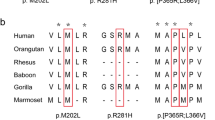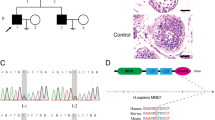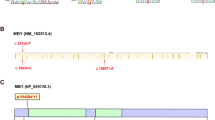Abstract
STAG3 is essential for male meiosis and testis of male Stag3−/− mice shows the histopathological type of germ cell maturation arrest (MA). Whether variants of the STAG3 gene exist in Chinese idiopathic non-obstructive azoospermia (NOA) patients needs to be determined. We recruited 58 Chinese NOA men with MA who underwent testis biopsy and 192 fertile men as the control group. The 34 exons of the STAG3 gene were amplified using polymerase chain reaction (PCR) and sequenced. We identified eight novel single nucleotide polymorphisms (SNPs), including two missense SNPs (c.433T > C in exon2 and c.553A > G in exon3), three synonymous SNPs (c.539G > A, c.569C > T in exon3, and c.1176C > G in exon8), and three SNPs in introns. The allele and genotype frequencies of the novel and other SNPs have no significant differences between two groups. Our results indicated that variants in the coding sequence of the STAG3 gene were uncommon in NOA patients with MA in Chinese population. Future studies in large cohorts of different ethnic populations will be needed to determine the association between the STAG3 gene and NOA.
Similar content being viewed by others
Introduction
Infertility affects approximately 10–15% couples who consider having offspring1. Roughly, 30–40% of all cases could be attributed to male origin, 30–40% to female origin, and the remainder involves both problems2. The male infertility was proposed to have several etiologies, including endocrine disorders, spermatic duct obstruction, cryptorchidism, testicular damage, cytogenetic abnormalities and Y-chromosome microdeletion3. Azoospermia is a form of male infertility that affects 10–20% of infertile men4, and nearly 50% of idiopathic azoospermia cases are considered to have a genetic basis5,6.
There are two types of azoospermia, i.e., obstructive azoospermia and non-obstructive azoospermia (NOA)7,8. According to the testicular biopsy, NOA have four histopathological types, including normal spermatogenesis, hypospermatogenesis, germ cell maturation arrest (MA) and Sertoli cell only syndrome2,9,10. Many mouse models have linked hundreds of genes with azoospermia, but only a few studies have identified gene variants in humans with NOA, such as SYCP3, NR5A1, TEX11,CYP1A1,TDRD9, SOHLH1, USP26, ZMYND15 and PIWIL411,12,13,14,15,16,17,18. MA is a form of azoospermia in which the cessation occurred at stage of germ cell formation and may have its own specific etiology19,20.
The stromal antigen 3 (STAG3) is involved in formation of cohesin core with three other proteins including SMC1β and two α-kleisins (RAD21L and REC8), and required for synaptonemal complex formation during meiosis21. Stag3–/– male mice showed no overt phenotype apart from sterility, which is due to azoospermia and meiotic arrest21,22. Notably, Stag3–/– spermatocytes only reached zygotene-like stage of prophase I, and apoptosis occurred23. These results suggest that STAG3 plays an essential role in meiosis and may be a candidate gene for NOA patients with MA24. In this study, we investigated whether perturbations of the STAG3 gene were present in Chinese idiopathic NOA patients with MA histopathology.
Methods
Participants
In this study, male patients newly diagnosed with idiopathic NOA were recruited from the Center for Reproductive Medicine, Shandong University, from January 2014 to December 2018. All NOA patients were diagnosed on the basis of an andrological examination that included medical history, ultrasound, physical examination, hormone analysis, semen analysis, karyotype testing, and Y chromosome microdeletion screening. Subjects with known reasons or any relevant history may account for their infertility, such as childhood disease, cryptorchidism, environmental exposure, radiation, heat and other negative environmental exposure, varicocele, chromosomal abnormalities, hypogonadotropic hypogonadism, obstructive azoospermia, repeated infections, iatrogenic infertility, testicular trauma, abnormal karyotype, or Y-chromosome microdeletions, epididymitis, epididymo-orchitis, orchitis and/or sexualiy transmitted infections25,26,27 were excluded.
According to the WHO recommendations and standards28, after two or more inspections of semen, testicular biopsies were performed in patients without available sperm. Biopsy samples were immersed in Bouin’s fluid and then sent for histopathology examination. MA histopathology in our study exhibited that spermatogenesis blocked at the spermatocyte stage (Supplemental Fig. S1). Participants include 58 Chinese MA patients, and their mean age was 28 ± 4.1 years. A total of 192 fertile men with normal sperm concentrations were used as control group, and their mean age was 29 ± 4.2 years. All samples were treated according to the National Regulation of Clinical Sampling in China. Informed consent was obtained from all participants. The study was approved by the Institutional Review Board of Reproductive Medicine of Shandong University on October 11, 2014 (document No. 42).
Polymerase chain reaction (PCR) and sequencing analysis
Genomic DNA from 58 MA patients and 192 control samples were extracted from peripheral blood. Thirty-four exons of the STAG3 gene (RefSeqGene NG_034114.1) were amplified by PCR using 26 pairs of primers (Table 1). PCR mix included Buffer (Mg2+ Plus), 2.5 mM dNTP Mixture, 5 μM of forward primer, 5 μM of reverse primer, DNA polymerase Taq (Hot Start Version), dH2O and genomic DNA in a final volume of 20 μl. PCR conditions were as follows: pre-denaturation 5 min at 95 °C, 35 cycles of denaturation 30 s at 95 °C, annealing 30 s at 58 °C (60 °C for exons 14, 19, and 20), and elongation 45 s at 72 °C, and finally end-elongation 7 min at 72 °C. PCR products were firstly analyzed by Agarose gel electrophoresis and then sequenced on an automated sequencer (PRISM 310; Applied Biosystems).
Statistical analysis
The Sanger sequencing data were analyzed with Sequencer 4.9 software (Gene Codes Corporation, USA). Statistical analyses were carried out by the Statistical Package for Social Science for Windows (SPSS, version 22.0, IBM Corp., USA). The chi-squared test or Fisher's exact test was used when appropriate, and P < 0.05 was considered statistically significant.
Ethics approval and guideline statement
The study was approved by the Institutional Review committee of Reproductive Medicine of Shandong University on October 11, 2014 (document No. 42). All methods were carried out in accordance with relevant guidelines and regulations.
Consent for publication
The publication consent was obtained from all participants.
Results
We sequenced the STAG3 gene in 58 patients with idiopathic NOA with MA histopathology and the control 192 fertile men. As shown in Table 2, we found 12 single nucleotide polymorphisms (SNPs), including 4 known SNPs and 8 novel SNPs. The 8 novel SNPs included 2 missense SNPs (c.433T > C in exon2 and c.553A > G in exon3), 3 synonymous SNPs (c.539G > A, c.569C > T in exon3, and c.1176C > G in exon8), and 3 SNPs in introns region. The allele and genotype frequencies of all SNPs have no significant differences between the cases and control group. No plausible variants were identified.
Discussion
The development of male gametogenesis includes the differentiation of spermatogonia, the process of spermatocyte meiosis, and spermatogenesis29,30. Meiosis is a critical stage in gametogenesis, in which alignment and synapsis of chromosome pairs occur, allowing the recombination of the maternal and paternal genomes31. Many of the gene variants in this process could have profound effects on gametogenesis and lead to male infertility22. Many gene knockout mouse models showed meiotic arrest in infertility, suggesting that they are candidate genes for NOA with MA histopathology32.
The STAG3 gene encodes a critical subunit of the meiosis-specific cohesin complex, ensures sister chromatid cohesion and enables correct synapsis and segregation of homologous chromosomes during meiosis19,27. While variant in STAG3 was identified in premature ovarian failure and oocytes in Stag3–/– female mice were arrested at early prophase I, the knockout male mice were also infertile and showed meiotic arrest and azoospermia33,34. These findings indicated that STAG3 may be a potential candidate gene for NOA in human. In this study, we analyzed the STAG3 gene in 58 Chinese NOA patients with MA histopathology, which is coincided with the phenotype of the gene knockout mice35. Eight novel SNPs were identified, including two missense SNPs, three synonymous SNPs and three SNPs in intron region. Our findings suggest that variants in coding region of the STAG3 gene are uncommon in NOA patients with MA histopathology in China. However, it has been reported that two SNPs (rs1727130 and rs1052482) located in the 3’-UTR of the STAG3 gene were identified to be associated with NOA in Korean population36. Furthermore, homozygous or compound-heterozygous variants of the STAG3 gene have been identified in NOA patients from Germany, Spain, and Australia37,38,39. In this study, we did not identify the same variants which may be due to the small sample size and ethnic diversity. Consistently, whole-exome sequencing was performed in 314 Han Chinese patients with unrelated NOA and Severe Oligozoospermia, but no deleterious variants were found in STAG340.
Conclusions
The present study investigated variants in STAG3 in a cohort of idiopathic NOA with MA histopathology, and found no pathogenic variants. Our results suggest that variants in the STAG3 gene may not be responsible for NOA with MA in Chinese population. However, due to ethnic diversity, the exact role of STAG3 in the pathogenesis of NOA needs to be explored in large samples and other populations in the future.
Data availability
The datasets used and analyzed during the current study are available from the corresponding author on reasonable request.
Abbreviations
- MA:
-
Germ cell maturation arrest
- NOA:
-
Non-obstructive azoospermia
- PCR:
-
Polymerase chain reaction
- SNPs:
-
Single nucleotide polymorphisms
- STAG3:
-
Stromal antigen 3
- SPSS:
-
Statistical Package for Social Science for Windows
References
Yafi, F. A. & Zini, A. Percutaneous epididymal sperm aspiration for men with obstructive azoospermia: Predictors of successful sperm retrieval. Urology 82, 341–344 (2013).
Bhasin, S., de Kretser, D. M. & Baker, H. W. Clinical review 64: Pathophysiology and natural history of male infertility. J. Clin. Endocrinol. Metab. 79, 1525–1529 (1994).
O’Flynn O’Brien, K. L., Varghese, A. C. & Agarwal, A. The genetic causes of male factor infertility: A review. Fertil. Steril. 93, 1–12 (2010).
Alhalabi, M. et al. High prevalence of genetic abnormalities in Middle Eastern patients with idiopathic non-obstructive azoospermia. J. Assist. Reprod. Genet. 30, 799–805 (2013).
Ammar-Khodja, F., Hamouli, Z., Boukerbout, F. F. & Djerroudib, K. The cytogenetic aspect of male infertility. Iran. J. Reprod. Med. 12, 835–836 (2014).
Capogrosso, P. et al. Male infertility as a proxy of the overall male health status. Minerva Urol. Nefrol. 70, 286–299 (2018).
Bonarriba, C. R., Burgues, J. P., Vidana, V., Ruiz, X. & Piza, P. Predictive factors of successful sperm retrieval in azoospermia. Actas Urol. Esp. 37, 266–272 (2013).
Liu, X. Z., Tang, Y. G., Liu, H., Tang, L. X. & Wen, R. Q. Relationship between testis volume and types of spermatogenic cells from testicular biopsy in patients with azoospermia or cryptozoospermia. Zhonghua Nan Ke Xue 16, 52–54 (2010).
Yatsenko, A. N. et al. X-linked TEX11 mutations, meiotic arrest, and azoospermia in infertile men. N. Engl. J. Med. 372, 2097–2107 (2015).
Jiang, H. et al. Meiotic chromosome behavior in a human male t (8;15) carrier. J. Genet. Genomics 41, 177–185 (2014).
Niederberger, C. Re: X-linked TEX11 mutations, meiotic arrest, and azoospermia in infertile men. J. Urol. 195, 444 (2016).
Zheng, L. R. et al. Association between XRCC1 single-nucleotide polymorphisms and infertility with idiopathic azoospermia in northern Chinese Han males. Reprod. Biomed. Online 25, 402–407 (2012).
Miyamoto, T. et al. Azoospermia in patients heterozygous for a mutation in SYCP3. Lancet 362, 1714–1719 (2003).
Abbas, M., Srivastava, K., Imran, M. & Banerjee, M. Association of CYP1A1 gene variants rs4646903 (T>C) and rs1048943 (A>G) with cervical cancer in a North Indian population. Eur. J. Obstet. Gynecol. Reprod. Biol. 176, 68–74 (2014).
Ropke, A. et al. Comprehensive sequence analysis of the NR5A1 gene encoding steroidogenic factor 1 in a large group of infertile males. Eur. J. Hum. Genet. 21, 1012–1015 (2013).
Arafat, M. et al. Mutation in TDRD9 causes non-obstructive azoospermia in infertile men. J. Med. Genet. 54, 633–639 (2017).
Cervan-Martin, M., Jose, A. C., Palomino-Morales, R. & David Carmona, F. Genetic landscape of nonobstructive azoospermia and new perspectives for the clinic. J. Clin. Med. 9, 300 (2020).
Munoz, X., Navarro, M., Mata, A., Bassas, L. & Larriba, S. Association of PIWIL4 genetic variants with germ cell maturation arrest in infertile Spanish men. Asian J. Androl. 16, 931–933 (2014).
Xu, T., Peng, L., Lin, X., Li, J. & Xu, W. Predictors for successful sperm retrieval of salvage microdissection testicular sperm extraction (TESE) following failed TESE in nonobstructive azoospermia patients. Andrologia. https://doi.org/10.1111/and.12642 (2017).
Tesarik, J. & Greco, E. Assisted reproduction for testicular failure: Management of germ cell maturation arrest. Curr. Opin. Obstet. Gynecol. 11, 283–288 (1999).
Garcia-Cruz, R. et al. Dynamics of cohesin proteins REC8, STAG3, SMC1 beta and SMC3 are consistent with a role in sister chromatid cohesion during meiosis in human oocytes. Hum. Reprod. 25, 2316–2327 (2010).
Hopkins, J. et al. Meiosis-specific cohesin component, Stag3 is essential for maintaining centromere chromatid cohesion, and required for DNA repair and synapsis between homologous chromosomes. PLoS Genet. 10, e1004413 (2014).
Llano, E. et al. STAG3 is a strong candidate gene for male infertility. Hum. Mol. Genet. 23, 3421–3431 (2014).
Winters, T., McNicoll, F. & Jessberger, R. Meiotic cohesin STAG3 is required for chromosome axis formation and sister chromatid cohesion. EMBO J. 33, 1256–1270 (2014).
Kumar, R. Medical management of non-obstructive azoospermia. Clinics (Sao Paulo) 68(Suppl 1), 75–79 (2013).
Kasak, L. & Laan, M. Monogenic causes of non-obstructive azoospermia: Challenges, established knowledge, limitations and perspectives. Hum. Genet. https://doi.org/10.1007/s00439-020-02112-y (2020).
Banyra, O., Nikitin, O. & Ventskivska, I. Acute epididymo-orchitis: Relevance of local classification and partner’s follow-up. Cent. Eur. J. Urol. 72, 324–329 (2019).
Shu, J. H. et al. Predictive value of sperm morphology according to WHO Laboratory manual for the examination and processing of human semen (5th ed) on the outcomes of IVF-ET. Zhonghua Nan Ke Xue 19, 414–417 (2013).
Neto, F. T., Bach, P. V., Najari, B. B., Li, P. S. & Goldstein, M. Spermatogenesis in humans and its affecting factors. Semin. Cell. Dev. Biol. 59, 10–26 (2016).
Fayomi, A. P. & Orwig, K. E. Spermatogonial stem cells and spermatogenesis in mice, monkeys and men. Stem Cell Res. 29, 207–214 (2018).
Hydbring, P., Malumbres, M. & Sicinski, P. Non-canonical functions of cell cycle cyclins and cyclin-dependent kinases. Nat. Rev. Mol. Cell Biol. 17, 280–292 (2016).
Ashley, T., Walpita, D. & de Rooij, D. G. Localization of two mammalian cyclin dependent kinases during mammalian meiosis. J. Cell Sci. 114, 685–693 (2001).
Heddar, A., Dessen, P., Flatters, D. & Misrahi, M. Novel STAG3 mutations in a Caucasian family with primary ovarian insufficiency. Mol. Genet. Genomics 294, 1527–1534 (2019).
Fukuda, T. et al. STAG3-mediated stabilization of REC8 cohesin complexes promotes chromosome synapsis during meiosis. EMBO J. 33, 1243–1255 (2014).
Wolf, P. G., Cuba Ramos, A., Kenzel, J., Neumann, B. & Stemmann, O. Studying meiotic cohesin in somatic cells reveals that Rec8-containing cohesin requires Stag3 to function and is regulated by Wapl and sororin. J. Cell Sci. 131, 212100 (2018).
Nam, Y. et al. The association of stromal antigen3 (STAG3) sequence variations with spermatogenic impairment in the male Korean population. Asian J. Androl. 22, 106–111 (2020).
van der Bijl, N. et al. Mutations in the stromal antigen 3 (STAG3) gene cause male infertility due to meiotic arrest. Hum. Reprod. 34, 2112–2119 (2019).
Riera-Escamilla, A. et al. Sequencing of a “mouse azoospermia” gene panel in azoospermic men: Identification of RNF212 and STAG3 mutations as novel genetic causes of meiotic arrest. Hum. Reprod. 34, 978–988 (2019).
Jaillard, S. et al. STAG3 homozygous missense variant causes primary ovarian insufficiency and male non-obstructive azoospermia. Mol. Hum. Reprod. 26, 665–677 (2020).
Chen, S. T. et al. Whole-exome sequencing of a large Chinese azoospermia and severe oligospermia cohort identifies novel infertility causative variants and genes. Hum. Mol. Genet. 29, 2451–2459 (2020).
Acknowledgements
The authors thank the patients for their participation.
Funding
This research was supported by grants from the National Natural Science Foundation of China (81873823), Young Scholars Program of Shandong University (2016WLJH26), and Medical and health science and technology development Program of Shandong province (2017WS107).
Author information
Authors and Affiliations
Contributions
All authors contributed to the study conception and design. Material preparation, and gathered the clinical data and testis samples of the participants were performed by R.L., Y.C. and R.Y.; data collection and supervised the clinical part of the study were performed by W.L., G.F. and H.Z.; data analysis was performed by W.L., X.G., J.M. and S.Z., The first draft of the manuscript was written by W.L. and S.Z. All authors commented on the manuscript. All authors approved the final version of the manuscript.
Corresponding authors
Ethics declarations
Competing interests
The authors declare no competing interests.
Additional information
Publisher's note
Springer Nature remains neutral with regard to jurisdictional claims in published maps and institutional affiliations.
Supplementary Information
Rights and permissions
Open Access This article is licensed under a Creative Commons Attribution 4.0 International License, which permits use, sharing, adaptation, distribution and reproduction in any medium or format, as long as you give appropriate credit to the original author(s) and the source, provide a link to the Creative Commons licence, and indicate if changes were made. The images or other third party material in this article are included in the article's Creative Commons licence, unless indicated otherwise in a credit line to the material. If material is not included in the article's Creative Commons licence and your intended use is not permitted by statutory regulation or exceeds the permitted use, you will need to obtain permission directly from the copyright holder. To view a copy of this licence, visit http://creativecommons.org/licenses/by/4.0/.
About this article
Cite this article
Liu, W., Gao, X., Zhang, H. et al. Analysis of STAG3 variants in Chinese non-obstructive azoospermia patients with germ cell maturation arrest. Sci Rep 11, 10077 (2021). https://doi.org/10.1038/s41598-021-89559-9
Received:
Accepted:
Published:
DOI: https://doi.org/10.1038/s41598-021-89559-9
Comments
By submitting a comment you agree to abide by our Terms and Community Guidelines. If you find something abusive or that does not comply with our terms or guidelines please flag it as inappropriate.



